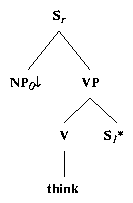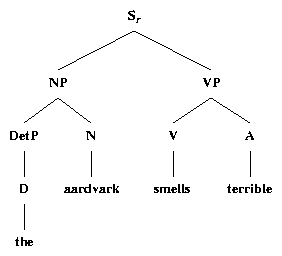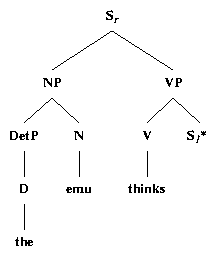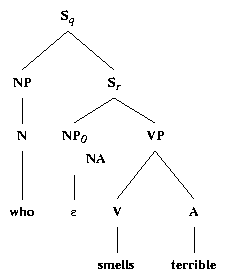

The need for an adjunction node rather than a substitution node at S1 may not be obvious until one considers the derivation of sentences with long distance extractions. For example, the declarative in ((37)) is derived by adjoining the tree in Figure 8.3(b) to the S1 node of the tree in Figure 8.3(a). Since there are no bottom features on S1, the same final result could have been achieved with a substitution node at S1.
 |
 |
|
| (a) | (b) |
However, adjunction is crucial in deriving sentences with long distance extraction, as in sentences ((38)) and ((39)).
The example in ((38)) is derived from the trees for who smells terrible? shown in Figure 8.4 and the emu thinks S shown in Figure 8.3(b), by adjoining the latter at the Sr node of the former.8.8 This process is recursive, allowing sentences like ((39)). Such a representation has been shown by [#!kj85!#] to be well-suited for describing unbounded dependencies.

In English, a complementizer may not appear on a complement with an extracted subject (the `that-trace' configuration). This phenomenon is illustrated in ((40))-((42)):
These sentences are derived in XTAG by adjoining the tree for did the giraffe say S at the Sr node of the tree for either which animal likes him (to yield sentence ((42))) or which animal he likes (to yield sentence ((40))). That-trace violations are blocked by the presence of the feature <assign-comp>=inf nil/ind nil/ecm feature on the bottom of the Sr node of trees with extracted subjects (W0), i.e. those used in sentences such as ((41)) and ((42)). If a complementizer tree, COMPs, adjoins to a subject extraction tree at Sr, its <assign-comp> = that/whether/for/if feature will clash and the derivation will fail. If there is no complementizer, there is no feature clash, and this will permit the derivation of sentences like ((42)), or of ECM constructions, in which case the ECM verb will have <assign-comp>=ecm (see section 8.6.4 for more discussion of the ECM case). Complementizers may adjoin normally to object extraction trees such as those used in sentence ((40)), and so object extraction trees have no value for the <assign-comp> feature.